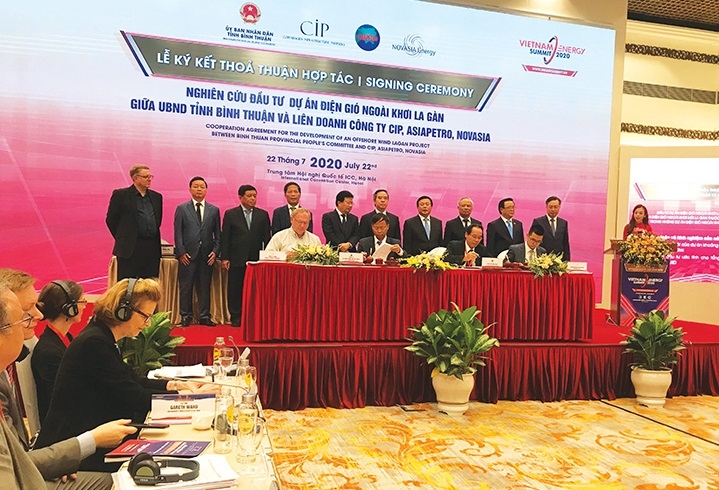New projects add drive to local energy sector
 |
| The $10 billion La Gan offshore wind power scheme was signed at last week’s Vietnam Energy Summit |
A series of MoUs on energy development worth tens of billions of US dollars were signed at last week’s Vietnam Energy Summit, cementing the belief of investors in the country’s untapped potential in the market. The summit was aimed to seek ways to implement the Politburo’s Resolution No.55-NQ/TW on orientations to national energy development towards 2030, with a vision to 2045, which was issued early this year.
Standing out among the deals, the $10 billion La Gan offshore wind power scheme, one of the first large-scale offshore wind power in Vietnam and with potential capacity of 3.5GW, was signed by Copenhagen Infrastructure Partners, Asiapetro, and Novasia Energy.
The project partners are already fully engaged in the development of close collaboration with the government of the south-central province of Binh Thuan, and other authorities, preparing a final investment decision after inclusion of the project into the Power Development Plan of Vietnam, according to their press release.
In addition, a $6 billion liquefied natural gas project developed by Chan May-Lang Co Economic Zone is expected to start construction in the first quarter of next year and launch the first phase of commercial operations in 2024. After that, the plant will provide an average power output of 24-25 billion kilowatt-hours per year.
John Rockhold, CEO and vice chairman of US-Vietnam group Chan May JSC said that a number of institutions had shown interest in financing the projects, including US Exim Bank, the US International Development Finance Corporation, and the International Finance Corporation.
Vietnam is trying to attract more of the private sector in energy to meet the high demand of fuel for economic development, as well as its strong commitments to reduce CO2 emissions. It has been estimated that to achieve this, the country requires new investment of about $10 billion annually frontloaded through 2030, higher than the average of $8 billion for the 2011-2015 period, according to the World Bank.
Nguyen Tam Tien, general director of Trung Nam Group, said, “Resolution 55 is considered leverage for private enterprises, but it requires the legal corridor and ministries to participate in a synchronous fashion.”
Tam added that private businesses like Trung Nam are interested in the resolution as it will encourage all economic sectors to participate in energy development, while at the same time remove various barriers currently hindering some ventures. Trung Nam is currently building a 500 kilovolt transformer station in the south-central province of Ninh Thuan. It is also implementing a series of renewable energy projects with the goal of joining more than 3,000MW in the provinces of Tra Vinh, Gia Lai, Dak Lak and Ninh Thuan in the next three years.
Meanwhile, the feed-in tariff (FiT) for wind is worrying investors. Under the regulations, the FiT is 8.5 US cents per kilowatt-hour for wind power projects on the mainland and 9.8 US cents per kWh for offshore schemes. The rates are applied to wind power plants connecting to the national grid and beginning generation before November 1, 2021.
Financiers have complained that normally, a solar power plant will take six to eight months depending on the progress of clearance. But to build a wind power plant, it takes a year to build equipment.
“Investors are being pressured both on price and production schedule,” emphasised one insider.
Nguyen Hai Minh, deputy director of BIM Energy – which has a 30MW solar venture connected to the grid – said, “We hope that the policies will be guided more specifically through electricity and investment laws so that investors can participate in a fair and transparent manner.”
| Tran Tuan Anh - Minister of Industry and Trade
The issuance of Resolution 55 is of great significance and comes at the right time as 2020 is the final year in implementing Vietnam’s five-year socio-economic development plan since 2016 and decade-long socio-economic development strategy. Also, this year Vietnam has embraced creation of the national socio-economic development strategy for the coming decade, reflecting the Party’s stance and vision on the country’s energy development cause. Resolution 55 has set forth a raft of new points in regards to national energy development to ensure national energy security and push up the country’s industrialisation and modernisation pace. It will help meet the requirements for rapid and sustainable economic development, along with self-reliance attached to international integration. It will also ensure defence and security, protection of the ecosystem, and increasing access to diverse energy resources at reasonable costs. In addition, Resolution 55 has put forward orientations on removing obstacles and facilitating participation of assorted economic sectors, particularly the private sector, into energy development in Vietnam. The resolution also made clear that in the forthcoming time the national energy development strategy will focus on developing diversified and suitable energy resources, with priority given to renewables. Resolution 55 has, thereby, opened new doors, allowing us to put trust into having in place a strategy that features fresh policies and mechanisms, including the regulatory framework, to gravitate towards the right direction, ensuring national energy security. The Ministry of Industry and Trade, as the central advisory agency to the government in the energy field, has crafted out and submitted to the government for enactment an action programme that could serve as the groundwork for penning out further action plans to expedite Resolution 55. The draft of the action programme is expected to be enacted imminently. To ensure effective and consistent implementation of Resolution 55 across the board, the general contents and each particular aspect of the resolution must be perused prudently. The new breakthrough points in the resolution such as diversifying energy sources in a suitable manner, further reviewing and presenting new breakthrough policy, and encouraging participation of the private sector into energy development, must be detailed by particular action programmes and resolutions from the government. Caitlin Wiesen - Resident representative, United Nations Development Programme
Vietnam is at a critical junction to make strategic choices for continued sustainable growth and leap to the next stage of economic development. It is clear that Vietnam will not achieve its full potential in renewable energy development without the full engagement and investment from the private sector. UNDP surveys of some large banks, institutions, and investors conducted in over the last two years show that between $10-15 billion is available for investment in renewable energy and energy efficiency in Vietnam, if key barriers are addressed. Firstly, a consistent concern raised by international investors is that the current power purchase agreement (PPA) model needs further improvement to reduce risk for lenders that prevents them from making long-terms commitments. We strongly recommend accelerating the pilot and adopting policies on direct PPA mechanisms between renewable energy developers and end users. Secondly, key challenges persist for energy efficiency. With regard to financing, financial institutions view energy efficiency projects as risky as they do not have confidence in the returns from such projects and they face the high transaction cost due to legal, technical, and transactional complexities. Thirdly, businesses, in particular micro-, small-, and medium-sized enterprises, are key contributors to the economy and job creation and have important roles in energy efficiency, environmental protection, and climate change action. These kinds of enterprises need support and training in preparing and implementing green bankable projects, access to de-risking instruments and targeted funds that will stimulate demand for green investment, and enhanced links to global value chains. It is very encouraging that the recently adopted public-private partnership law has brought in great potential for private investment, especially in the energy sector. |
What the stars mean:
★ Poor ★ ★ Promising ★★★ Good ★★★★ Very good ★★★★★ Exceptional
Themes: Towards Sustainability
Related Contents
Latest News
More News
- Vietnam eases policy approval requirements, simplifies foreign and outbound investments (December 11, 2025 | 17:53)
- Unpacking new momentum in Vietnam’s M&A market (December 10, 2025 | 09:59)
- Forum honours outstanding M&A deals, strategies, and advisory firms (December 09, 2025 | 18:22)
- Vietnam enters defining phase of M&A growth (December 09, 2025 | 17:00)
- Vietnam’s M&A market opens new opportunities amid strong economic momentum (December 09, 2025 | 15:00)
- Vietnam M&A Forum 2025: new position, new momentum (December 09, 2025 | 14:30)
- FDI in Vietnam jumps on additional capital and share purchases (December 09, 2025 | 13:56)
- VIR gathers dealmakers for M&A forum (December 08, 2025 | 17:17)
- Vietnam steps up green transformation with strong policies and rising investment demand (December 06, 2025 | 12:07)
- Listed companies honoured for information transparency (December 06, 2025 | 11:59)



 Tag:
Tag:






















 Mobile Version
Mobile Version